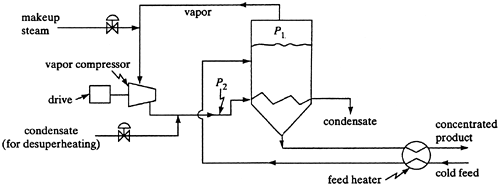8.8. EVAPORATION USING VAPOR RECOMPRESSION
8.8A. Introduction
In the single-effect evaporator, the vapor from the unit is generally condensed and discarded. In the multiple-effect evaporator, the pressure in each succeeding effect is lowered so that the boiling point of the liquid is also lowered in each effect. Hence, there is a temperature difference created for the vapor from one effect to condense in the next effect and boil the liquid to form vapor.
In a single-effect vapor-recompression (sometimes called vapor-compression) evaporator, the vapor is compressed so that its condensing or saturation temperature is increased. This compressed vapor is returned back to the heater of steam chest and condenses so that vapor is formed in the evaporator (B5, W1, Z1). In this manner the latent heat of the vapor is used and not discarded. The two types of vapor-recompression units are the mechanical and the thermal type.
8.8B. Mechanical Vapor-Recompression Evaporator
In a mechanical vapor-recompression evaporator, a conventional single-effect evaporator similar to that in Fig. 8.2-2 is used, as shown in Fig. 8.8-1. The cold feed is preheated by exchange with the hot outlet liquid product and then flows to the unit. The vapor coming overhead does not go to a condenser but is sent to a centrifugal or positive-displacement compressor driven by an electric motor or steam. This compressed vapor or steam is sent back to the heat exchanger or steam chest. The compressed vapor condenses at a temperature higher than the boiling point of the hot liquid in the effect, and a temperature difference is set up. Vapor is again generated and the cycle repeated.
Figure 8.8-1. Simplified process flow for mechanical vapor recompression evaporator.

Sometimes it is necessary to add a small amount of makeup steam to the vapor line before the compressor (B5, K2). Also, a small amount of condensate may be added to the compressed vapor to remove any superheat, if present.
Vapor-recompression units generally operate at low optimum-temperature differences of 5-10°C. Hence, large heat-transfer areas are needed. These units usually have higher capital costs than multiple-effect units because of the larger area and the costs of the relatively expensive compressor and drive unit. The main advantage of vapor-recompression units is their lower energy costs. Using the steam equivalent of the power to drive the compressor, the steam economy is equivalent to a multiple-effect evaporator of up to 10 or more units (Z1).
Some typical applications of mechanical vapor-recompression units are evaporation of seawater to give distilled water, evaporation of kraft black liquor in the paper industry (L2), evaporation of heat-sensitive materials such as fruit juices, and crystallization of salts having inverse solubility curves, where the solubility decreases with increasing temperature (K2, M3).
Falling-film evaporators are well suited for vapor-recompression systems (W1) because they operate at low-temperature-difference values and have very little entrained liquid which can cause problems in the compressor. Vapor recompression has been used in distillation towers where the overhead vapor is recompressed and used in the reboiler as the heating medium (M2).
8.8C. Thermal Vapor-Recompression Evaporator
A steam jet can also be used to compress the vapor, in what is called a thermal vapor-recompression evaporator. Its main disadvantages are the low efficiency of the steam jet, necessitating the removal of this excess heat, and the lack of flexibility to changes in process variables (M3). Steam jets are cheaper and more durable than mechanical compressors and can more easily handle large volumes of low-pressure vapors.
